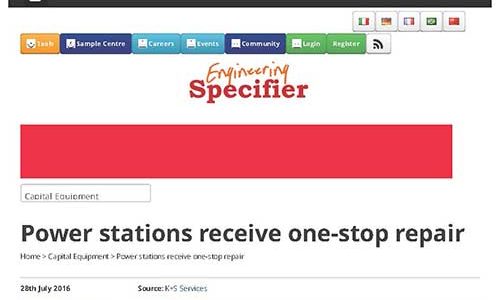Power stations receive one-stop repair

Whether powered by coal, oil or natural gas, nuclear or cleaner renewable resources like solar, wind, wave and hydroelectric, today’s electric power stations are comprised of a combination of mechanical and electronic components that go well beyond the primary generators that actually create the electrical current.
On the short list of common equipment found in power plants are transformers, motors, alternators, exciters, circuit breakers, relays, isolators, lighting arresters, batteries and other equipment.
To monitor and control this equipment, power plants incorporate digital elements in industrial-grade control and automation systems designed to monitor equipment status, facilitate troubleshooting and provide remote telemetry and control.
Given the vast array of mechanical and electronic parts involved, the seemingly straightforward task of maintaining the equipment is often a logistical nightmare that involves farming out components to a variety of specialty repair shops with variable capabilities, quality, pricing and turnaround time.
A motor or transformer repair shop, for example, does not have the capability to replace the power supplies, I/O, memory or communication cards in sophisticated PLC systems. Nor can they repair HMI systems that provide the local operator with a portal into the process, providing visualization of plant status and condition, logging of events and metering, and annunciation of alarm conditions.
Fortunately, international repair service companies, such as K+S Services for example, are responding by broadening its capabilities to provide more of a one-stop-shop service for power plants, often with facilities strategically located near major manufacturers or manufacturing regions.
Molding equipment
Due to size and expertise in many industries from automotive to aerospace, the unique repair service provider is equipped to offer an array of repair services under one roof. For the power generation industry specifically, that includes the full gamut of repair and replacement services from mechanical items (motors, transformers, etc.) to sophisticated electronic components such as PLCs and HMI control panels.
Regardless of the type of part, the company provides maintenance personnel with an initial evaluation to identify the probable cause of failure, and then repairs and tests the part according to the manufactures’ specifications and test procedures.
Proximity of repairs
K+S Services is also unique in the repair service business as it pursued a strategic model of expansion by opening new locations in close proximity to existing major plants, as well as geographic regions that attract and support U.S.-based manufacturing.
The company now operates eleven facilities across the globe, including the U.S., Mexico, Canada, and Europe. More than just a storefront with a lone representative that coordinates with a larger office, these repair facilities are fully equipped and functioning shops with managers, technicians and spare parts at each location.
Proximity, after all, has many advantages for a power plant. First and foremost, having a repair service in close proximity means repairs can be completed faster and the maximum possible uptime maintained.
In the event of an emergency, turnaround time is practically negligible. Cases exist where a part has been picked up in the morning, repaired, tested, and returned that same day.
If physical proximity in terms of location has its benefits, there is no relationship closer than having a repair service representative stationed within the plant itself.
With the company’s STAMP, customers are assigned a full-time, on-site account manager to serve as a one-stop facilitator and manager of all repairable assets within a specific plant.
This includes tracking all repairs, expediting when required, shipping or delivering to and from the nearby repair facility, maintaining database integrity, streamlining and stabilizing procedures, generating a wide variety of reports and keeping the customer informed throughout the process.
Read the article here